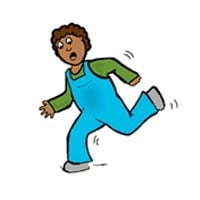Slips trips and falls are among the most common causes of accidents and injury at work.
Table of Contents
Slips:
A slip occurs when there is too little traction or friction between the shoe and the walking surface.

Trips :
The main cause of trips is obstructions in walking areas. A trip occurs when a person’s foot contacts an object in their way or drops to a lower level unexpectedly, causing them to be thrown off balance.

Falls:
A fall occurs when you are too far off balance.

Types of falls:
There are two types of falls:
Same Level:
When you fall to the surface you are walking on. Same level falls are more common. Caused by:
- Slips
- Trips
From Elevation
When you fall to a level below the one you are walking on. Falls from elevation are more severe. Caused by:
- Ladders
- Stairs
- Platforms
- Loading docks
Small Height Specification
- Working heights up to 2m
- Ladders (where safety harness use in not mandatory), stairs, ramps
- All landings at any height (e.g. floors in a building)
- All tables, stools etc.
The cost of slips, trips & falls:
Slips, trips, and falls can occur almost anywhere at the worksite and the incidents often have serious outcomes, resulting in debilitating injuries and even death.
- pain (from bruises, sprains, strains or fractures)
- temporary or permanent disability
- reduced quality of life
- depression
- inconvenience
Causes of Slips:
- Wet spills or contamination on floors
water, oil, grease etc. - Transitioning from one surface to another
e.g., floor to mat - Dry contamination on floors
dusts, powders, wood, plastic, etc. - Metal surfaces such as platforms and walkways .(Metal has lower traction than many other surfaces, so it can become very smooth with wear, becoming even more hazardous when wet).
- Mounting and dismounting equipment
- Climbing up and down ladders
- Uneven surfaces or terrain
- Loose, unanchored mats or rugs
- Wet, muddy or greasy shoes
- Sloped walking surfaces .
Causes of Trips:
- Uncovered cables, wires or extension cords (temporary wiring)
- Clutter, obstacles in walkways
- Changes in elevation, e.g. unmarked steps
- Carpets or mats that are not lying flat or have rolled up edges
- Irregular walking surfaces
- Non-uniform or irregular steps
- Accumulated waste materials or debris
- Trailing cables, pallets, tools, etc. in walkways
- Objects protruding from walking surface
- Uneven surface .
Cause of Fall :
Fall incidents in the work environment frequently involve slippery, cluttered or unstable walking/working surfaces; unprotected edges; floor holes and wall openings; unsafely positioned ladders; and misused fall protection”.
To reduce the risk of falling at work, you must be paying attention to your surroundings and walking at a pace that’s suitable for the surface you’re on and the task you’re performing. Additionally, walk with your feet pointed slightly outward, make wide turns when walking around corners and use the handrails on stairs.
Slip trip and fall Prevention:
- Provide awareness posters.
- Provide signboards where slip, trip, and fall accidents frequently occur.
- Obstruction in the workplace ( Like cables, Covers the cables that cross the walkways).
- Good lighting can prevent slip, trip, and fall.
- Clean all spills immediately.
- Clean the debris from the floor by sweeping or mopping.
- Wear shoes properly. Anti-slippery shoes are the best for use.
Reduce the risk of slipping on wet flooring by:
- taking your time and paying attention to where you are going
- adjusting your stride to a pace that is suitable for the walking surface and the tasks you are doing
- walking with the feet pointed slightly outward
- making wide turns at corners
Reduce the risk of tripping by:
- keeping walking areas clear from clutter or obstructions
- keeping flooring in good condition
- always using installed light sources that provide sufficient light for your tasks
- using a flashlight if you enter a dark room where there is no light
- making sure that things you are carrying or pushing do not prevent you from seeing any obstructions, spills, etc.
How housekeeping prevents slips and trips accidents?
Good housekeeping is the first and the most important (fundamental) level of preventing falls due to slips and trips. It includes:
- Cleaning all spills immediately
- Marking spills and wet areas
- Mopping or sweeping debris from floors
- Removing obstacles from walkways and always keeping walkways free of clutter
- Securing (tacking, taping, etc.) mats, rugs and carpets that do not lay flat
- Always closing file cabinet or storage drawers
- Covering cables that cross walkways
- Keeping working areas and walkways well lit
- Replacing used light bulbs and faulty switches .
Without good housekeeping practices, any other preventive measures such as installation of sophisticated flooring, specialty footwear, or training on techniques of walking and safe falling will never be fully effective.
FAQs for slips, trips and falls?
What are the leading causes of slips, trips, and falls?
The leading causes of slips, trips, and falls are:
1. Wet floors.
2. Slippery floors.
3. Unsuitable footwear.
4. Uneven flooring.
5. Poor or bad housekeeping.
6. Oil on floor.
7. Bad lighting.
8. Obstructions on the floor.
9. Trailing cables.
10. Damaged floors, etc.
What is the difference between a slip, trip, and fall?
Slip:
A slip occurs when there is too little traction or friction between the shoe and the walking surface.
Trip:
A trip occurs when a person’s foot contacts an object in their way or drops to a lower level unexpectedly, causing them to be thrown off balance.
Fall:
A fall occurs when you are too far off balance.

